Finding the Next Sun God
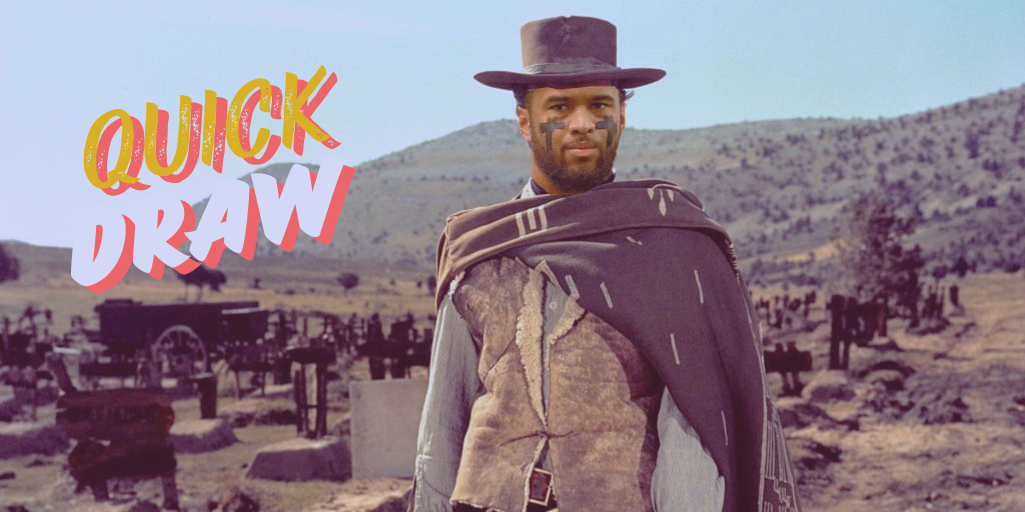
Mike McDaniel thinks impatience is a virtue. Sometimes, that means skipping a night's sleep and calling an 8 a.m. meeting that leads to your team trading for the fastest player in the NFL.
Miami's front office had planned to sign some hogmollies to protect Tua Tagovailoa, back in 2022, but McDaniel argued they should instead spend their resources on speed.
The first-year head coach had compiled a 700-play highlight reel to share with his quarterback and discovered Tagovailoa "could sense an opening before it happened." He was more accurate and got rid of the ball faster than most "star quarterbacks," McDaniel told The Washington Post.
The advanced stats matched the film study so the front office shipped a boatload of picks to Kansas City for Tyreek Hill. Then, the season happened. Tua suffered multiple brain injuries that left him lying on the ground and unable to move, with his hands frozen above his chest like mangled claws.
During the 2023 offseason, Tua confessed he had considered retirement but decided he was too young to walk away and wanted his son to grow up knowing what dad did for a living.
He started practicing jiu-jitsu in an effort to better protect himself from further head trauma. It was meant to teach him how to take hits and fall without smacking his head off the turf.
Once again, the Dolphins decided against spending major assets on pass protection during free agency and the draft. They signed a few veteran wideouts and drafted Texas A&M running back/All-American track star De'Von Achane, who ran the 200 meter dash in 20.20 seconds. As draftnik Dane Brugler pointed out in his prospect guide, "the standard 200-meter time for Olympic Trial qualifiers is 20.24" seconds.
But you already knew that: Achane is fast and the Dolphins are explosive. What I really wanted to know is why they seemed so much more explosive than everybody else.
Over the course of the 2023-24 season, Tua shaved 0.2 seconds off his career marks for average time to throw, getting rid of the ball in 2.34 seconds. When parsing that number using Pro Football Focus's Time in Pocket stat, though, more often than not Tua was getting rid of the ball even faster than that.
In quick-passing scenarios, Tua's average time to throw was 1.77 seconds. Among quarterbacks with more than 300 dropbacks, only Patrick Mahomes and Josh Allen held onto the ball for milliseconds less, with Mahomes at 1.70 seconds and Allen at 1.76 seconds.
How the Dolphins really separated themselves from the Chiefs and Bills was how quickly they were able to push the ball downfield.
Average Depth of Target (less than 2.5 seconds to throw)
- Patrick Mahomes: 2.3 yards (aDOT)
- Josh Allen: 3.6 yards (aDOT)
- Tua Tagovailoa: 5.8 yards (aDOT)
The Dolphins also called these quick passes more often than the Chiefs and Bills.
- Patrick Mahomes: 42.7% of dropbacks (DBs)
- Josh Allen: 46.6% of DBs
- Tua Tagovailoa: 61.7% of DBs
In 2023, that meant Tua was attempting about 22 quick passes per game and completing 16 of them.
He was third in the NFL in yards per completion on quick throws and one of three signal callers to average better than 10 yards per quick completion.
- Tua Tagovailoa: 10.59 yards
- Jake Browning: 11.07 yds (Joe Burrow: 8.25 yds)
- Brock Purdy: 11.80 yds
However, Browning and Purdy didn't complete nearly as many quick completions per game as Tagovailoa.
- Tua Tagovailoa: 16.11/per game
- Jake Browning: 12/gm (Joe Burrow: 17/gm)
- Brock Purdy: 9.68/gm
Overall, that made for a stark difference in yards per game on quick throws.
- Tua Tagovailoa: 170.61 passing yards per game on quick completions
- Jake Browning: 132.89 yds (Joe Burrow: 139.20 yds)
- Brock Purdy: 114.26 yds
Here's how the rest of the Top 15 stacked up.
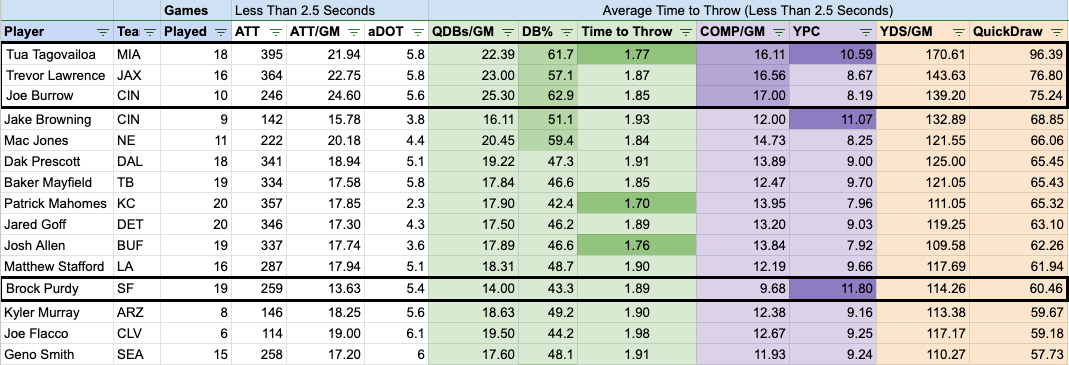
So, alright: why is this relevant for fantasy football?
Mike McDaniel has turned the game of inches into a game of milliseconds and turned Tua Tagovailoa into the Quickest Draw in the West.
For fantasy, it makes sense to target the quick game and compile those sweet, sweet PPR points. As Denny Carter recently pointed out, there's nothing wrong with wanting the easy stuff.
To that effect, the first player the Dolphins signed in free agency this offseason was tight end Jonnu Smith. I wondered why he was such a priority for McDaniel and the front office, but it didn't take long to figure that out.
Jonnu Smith reached a top speed of 21.15 mph on his 60-yard touchdown, the 3rd-fastest speed by a tight end as a ball carrier in the NGS era (since 2016).
— Next Gen Stats (@NextGenStats) November 5, 2023
Smith is the only TE to reach 20+ mph as a ball carrier since the start of last season.#MINvsATL | #DirtyBirds pic.twitter.com/PO2nRfir4b
In the animation above, Taylor Heinicke takes the shotgun snap and immediately fires out wide to Jonnu Smith for a tight-end screen. Jonnu gets key blocks from fellow TE MyCole Pruitt and the right side of the Falcons' line and is off to the races, hitting a top speed of 21.15 mph (third fastest by a TE since 2016).
Smith's athleticism brings welcome juice to the Dolphins TE room that will force defenses to pay more attention to where he's lined up before the snap.
Imagine the play below against the Chiefs with Jonnu on the field instead of Julian Hill. (Julian's the tight end in Tua's sightline running across the NFL shield).
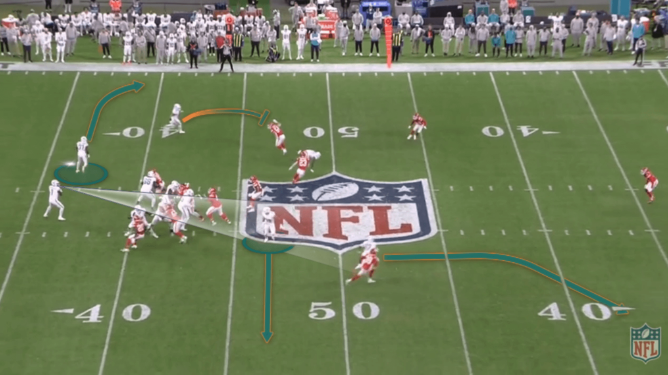
Maybe Tua and McDaniel would've been more willing to take the checkdown rather than wait for Tyreek to get open downfield, which resulted in an incompletion.
Last November, The Athletic's Ted Nguyen wrote about the Dolphins tendency to forgo the easy stuff in favor of explosive plays. That was all fine and dandy when the Dolphins were blowing out bad teams. However, when they played a team with a winning record their effectiveness fell off a cliff.
Just how bad did it get? When Tua held onto the ball for more than 2.5 seconds against good teams, he was less effective than Zach Wilson. In fact, he was more than three times as bad.
Nguyen added:
There’s a better balance between going deep and short that the Dolphins have to find. Aggressiveness has served Tua Tagovailoa well, but sometimes, it’s OK to drive the ball with short passes, especially when defenses are dropping so deep against them.
Jonnu Smith should also help open things in the run game, which got faster in the draft with 4th-round pick Jaylen Wright.
The former Volunteer ran a 4.38 forty at the NFL Combine and recently turned 21 years old. With Raheem Mostert (who recently turned 32) and De'Von Achane's injury histories, adding another speed demon to the backfield should help the Dolphins' quick-passing game stay on schedule this season and beyond.
Nguyen also suggests the Dolphins' rushing attack could take advantage of light boxes with inside handoffs when the defense is spread out to cover the Dolphins perimeter threats.
Against the Chiefs, on the potential game-winning drive, Raheem Mostert had runs of 25 and 19 yards on inside runs against light boxes.
Seventh-round wideout Tahj Washington might be able to help in both areas. Pro Football Focus's Trevor Sikkema noted USC "used him all over," lining him up in the backfield and out wide as a slot, flanker, H-back, and running back.
The former Trojan was Caleb Williams' most productive receiver at USC last season, leading the team in catches, receiving yards, 1st-down receptions, and contested catches despite standing 5'9" and weighing 174 lbs.
Tahj played in Lincoln Riley's spread scheme with heavy motion the past two seasons, which should make for an easy transition into the Dolphins' jet-motion wrinkle that was quickly copied by playcallers around the league.
“We call it ‘cheat’ because it’s cheating,” Kyle Shanahan said in September. “It’s cool to get ’em running sideways, and still hit it vertically.” Lucky for Shanahan and McDaniel and the rest of the creative playcallers league-wide, the NFL did not ban "cheat" during their annual rules summit this spring.
As a refresher, here's how lethal it can be.
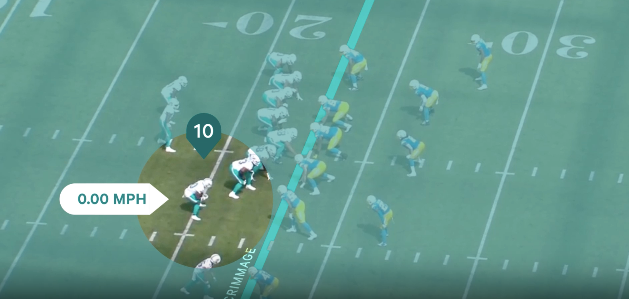
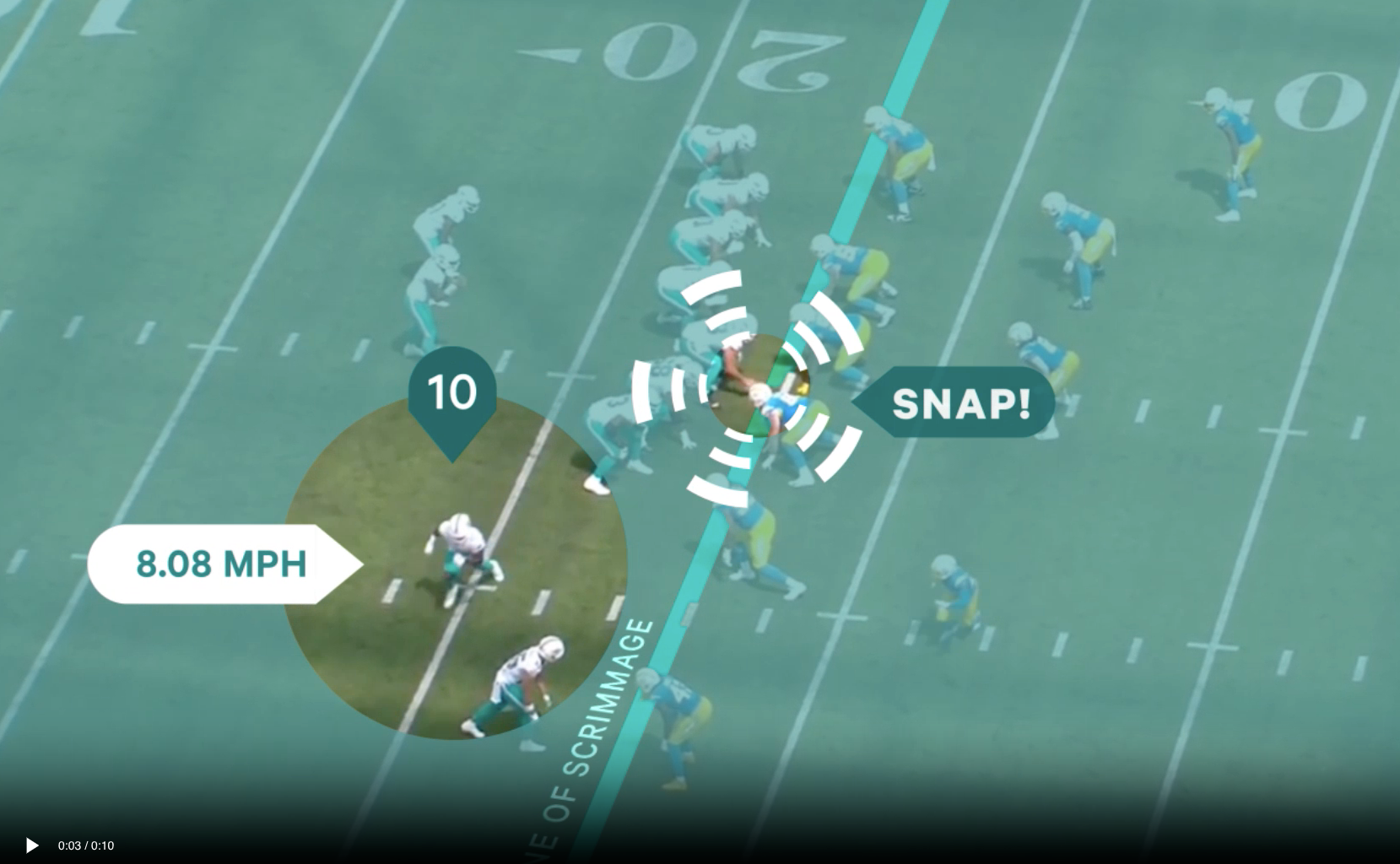
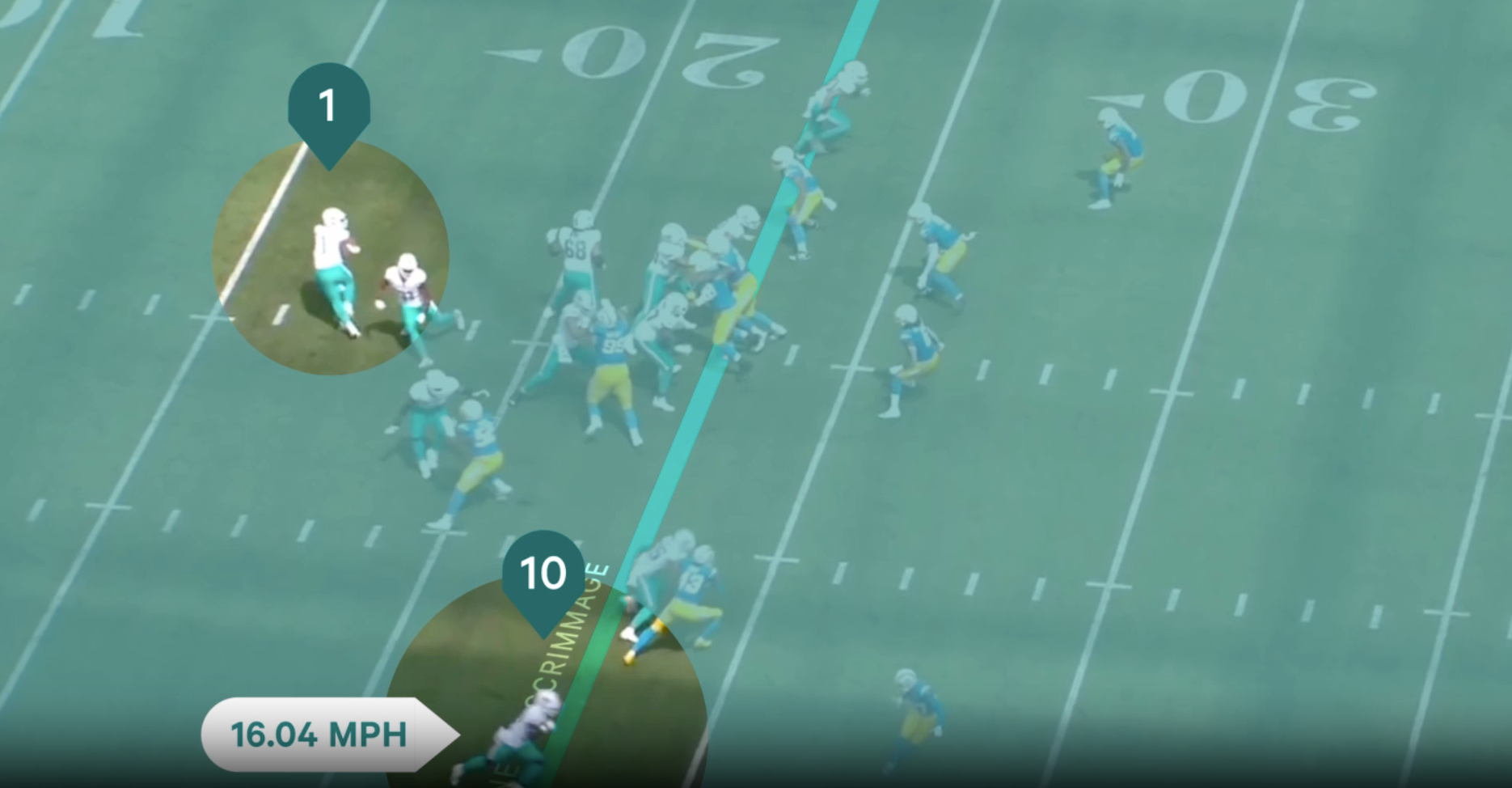
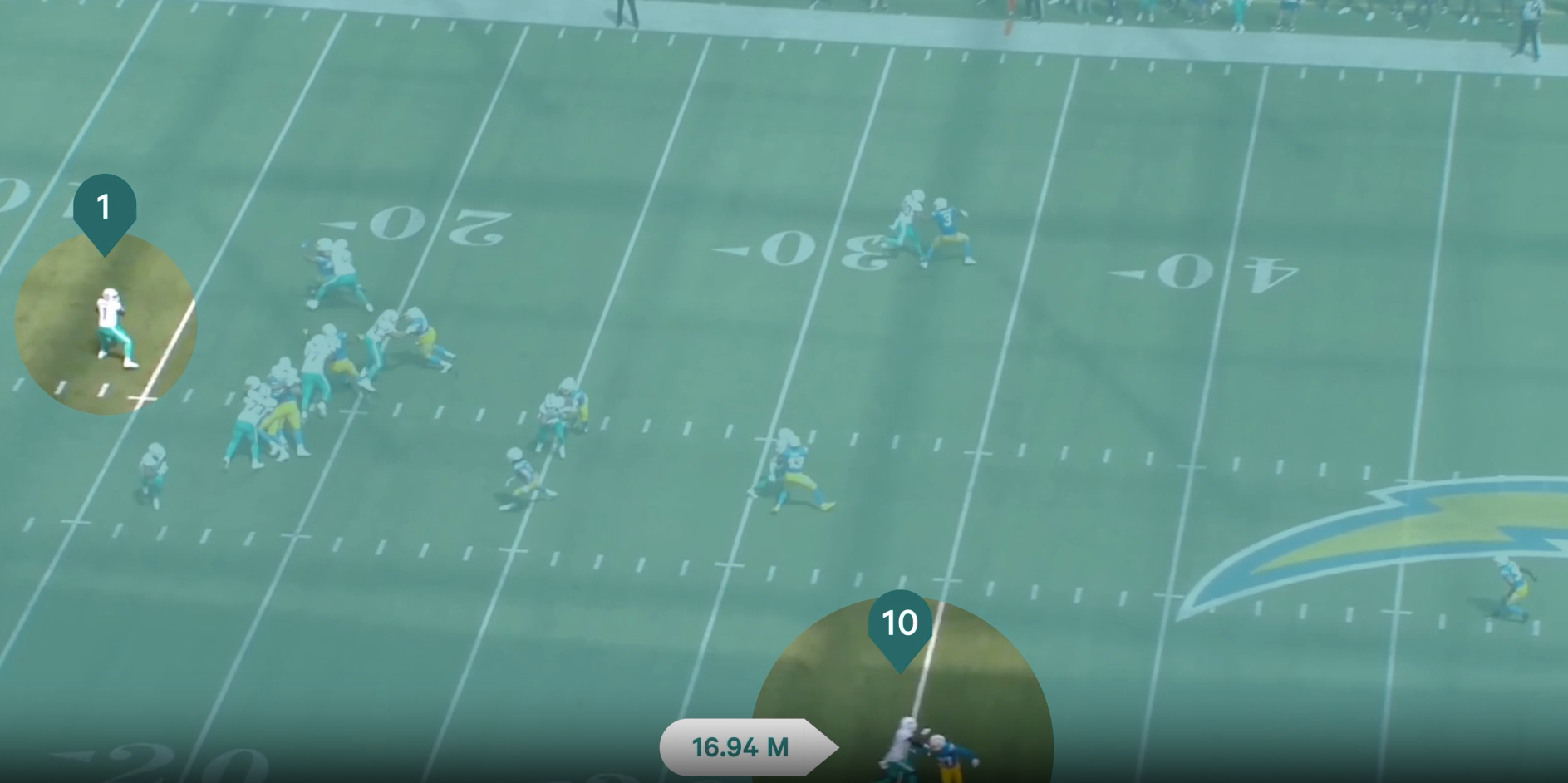
Play diagram by Drew Jordan (The Athletic)
In this play against the Chargers, Tua lined up in shotgun, which should've tipped off the defense that the play may take more than 2.5 seconds to develop.
One way to neutralize that tip? Get Tyreek Hill up to 8 mph by the time the ball is snapped and 16 mph by the time he hits the line of scrimmage. When Tyreek breaks his route off toward the middle of the field, the cornerback is completely turned around and Tua hits Tyreek in stride for a 20+ yard explosive play.
The "cheat" is the motion before the snap that allows Tyreek to get up to 8 mph in a step or two.
The Athletic's Jourdan Rodrigue reported on the Dolphins commitment to getting the timing of these motions just right.
Over seemingly endless reps last summer, Tagovailoa and the offense timed the concept so that the motion player could legally cut upfield right at the snap.... NFL motion rules prohibit vertical movement until the ball is snapped, as well as multiple simultaneous motions.
As awesome as this wrinkle was for the Dolphins and copycats around the league, better teams were able to keep up with their speed and the Dolphins became more predictable, had more negative plays, and were frequently penalized for holding calls and false starts.
Nguyen: "Those plays will remain a big component of the offense, but the Dolphins have to turn down the dial a notch.... Against better teams, the Dolphins have to learn how to eat their vegetables. It doesn’t have to be the whole meal, but they need to have a place on the plate. That also includes checking the ball down and not trying to force-feed Tyreek Hill so much."
I believe the Dolphins ate their vegetables with the 184th pick in the draft.

Malik Washington's top routes are hitches, outs, screens, and corners. Travis Wingfield of the Miami Dolphins Podcast Network adds:
"That's where the space exists within the Dolphins' current personnel and some things that teams took away last year."
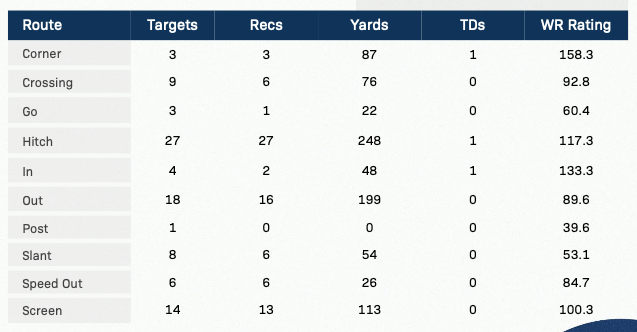
Malik led all of college football with 110 receptions, 10 games of 100+ yards, and 35 forced missed tackles in 2023. To be fair, it was his fifth season of eligibility.
During his first four years in school, Malik studied at Northwestern and was a three-time Academic All-Big Ten honoree. He graduated with his degree in psychology, then transferred to Virginia and earned his master's degree in higher education—all while being the most productive wide receiver in college football.
In a three-game sample reviewed by Yahoo! Sports and Reception Perception's Matt Harmon, Washington was brought down on first contact on 45% of 20 attempts and broke multiple tackles on a handful of them.
"He's a YAC player, a run after catch player, perfect for the Dolphins offense, reliable, has the hands."
Over 52 games, Malik caught 230 passes while only registering six drops.
Steve Smith, whom Malik grew up idolizing, invited him on his podcast during the pre-draft process. The two broke down Malik's game tape and Steve gave his stamp of approval.
I thought you really understood exactly how to play in the slot, the rhythm and the timing of the offense. I think you don't need to be taught that. It's instinctively who you are.
He then asked Malik "what's your 'why' in running routes?"
Malik: "When I think about routes, it's to get open—I want to be quarterback friendly. So, every single play when I'm running my route it's to be available for the quarterback, to find a way — if he's getting pressured, if he's scrambling, any instance — I gotta be open for him. It's less about me doing all the stuff in my route. It's about being open as quick as possible for my quarterback."
They end the interview by talking about the common scouting malpractice of player comparisons and how shorter wide receivers only ever get compared to other shorter WRs, guys like Wan'Dale Robinson and Tutu Atwell.
"I don't understand why [the comp's] not on play style. Why are they always trying to match up a frame or forty time."
I've got your back, Malik. How does Amon-Ra St. Brown sound for a comp?
Let's start with the stuff everyone's trying to match up.
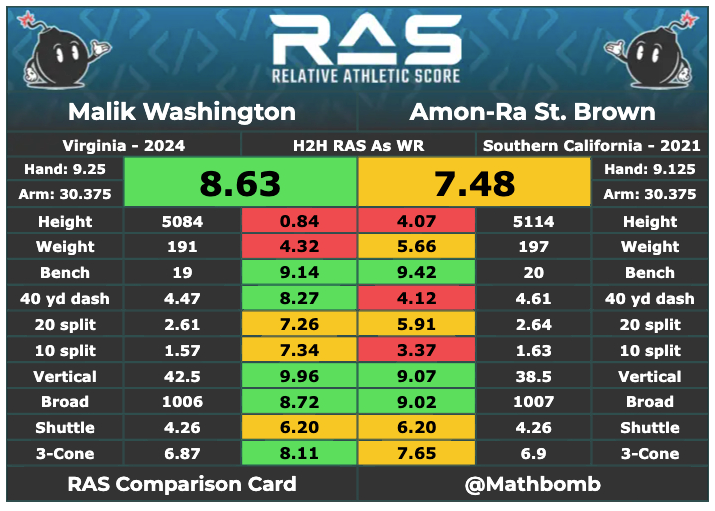
What jumps out? To me, it's the bench press, and I think that speaks to Malik's want for comps to be based on play style. "You can feel his rugged toughness on tape," an NFL Scout told Dane Brugler, who added Malik has "better finishing skills than his size would suggest."
Looking back at Brugler's 2021 prospect guide, he had this to say about St. Brown: "Physical after the catch and runs with tackle-breaking strength."
The similarities between the two don't stop there:
- High-level body control, excellent adjustment and tracking skills
- Strong hands, drops are rare
- Instinctively read coverage, create separation
Brugler also notes their weaknesses. Here's the first line of each:
- Amon-Ra: "Not an intimidating target, with only average height and length"
- Malik: "Undersized and underpowered with short arms"
Lucky for us, this does not matter for fantasy football. In fact, since (at least) 2017, I would argue their relatively smaller stature is a strength.
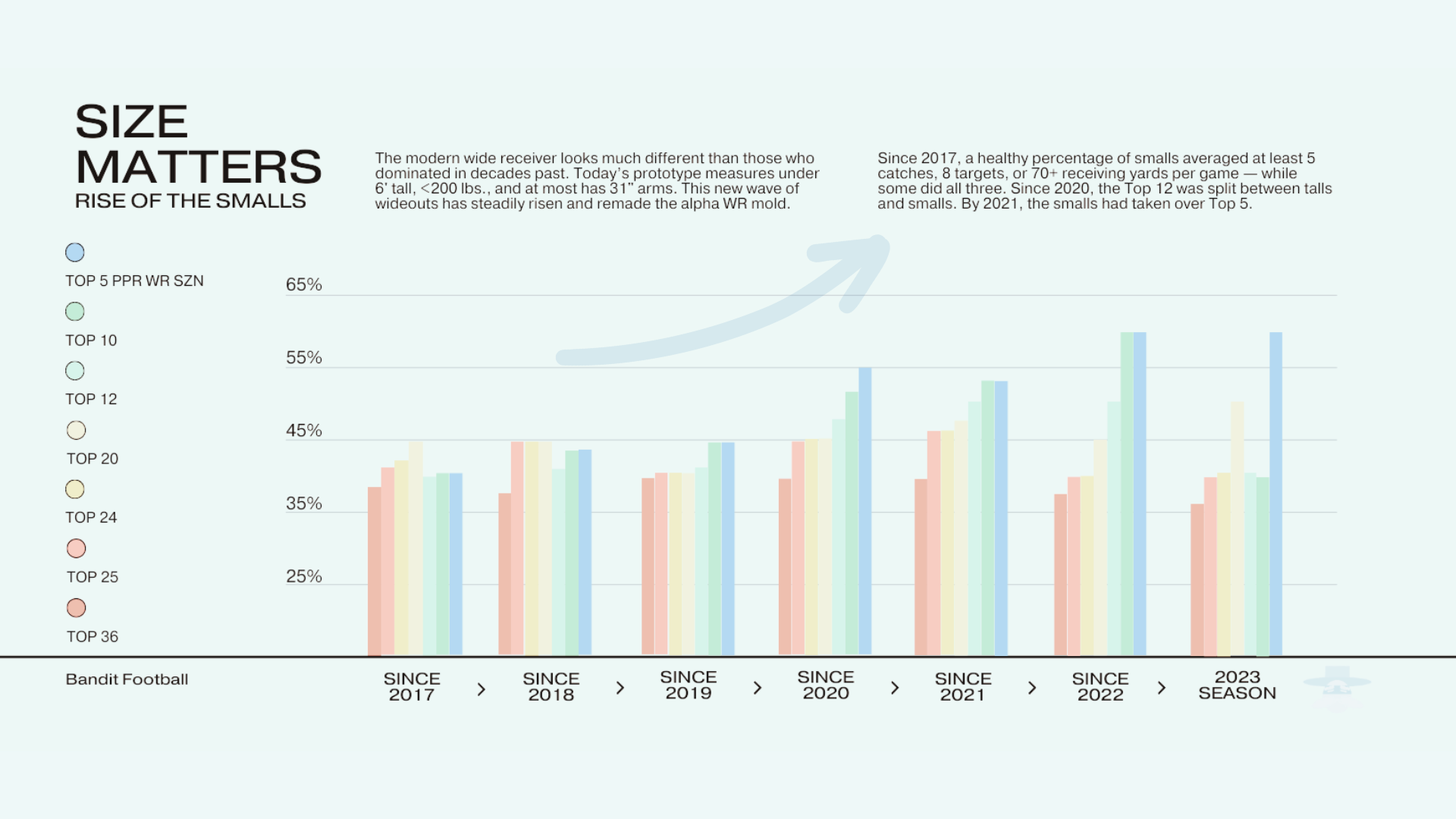
I looked at FantasyPros' season-long data for wide receivers dating back to 2017 and broke down the Top 36 in each season by a few key size metrics: height, weight, arm length.
Prospects routinely described as undersized by the scouting community typically stand under 6' tall, weigh under 200 lbs., and/or have at most 31" arms.
I wanted to know which of the Top 36 PPR WRs fell into the "smalls" bucket while also tallying at least 5 catches, 8 targets, or 70+ receiving yards per game on a season-long basis.
By the 2020 season, the WR1s were split down the middle between talls and smalls, but the shorter receivers had taken over the Top 5.
Why did I start with the 2017 season? That's when Sean McVay was hired by the Rams and 11 personnel swiftly took over the league.
This is the new normal in the NFL: starting three wide receivers and one running back is the base offensive formation. Defenses have countered by shifting from their traditional 3-4 or 4-3 fronts by subtracting a linebacker and adding a slot or nickel cornerback. In 2023, the Associated Press added slot cornerback to their All-Pro rosters for the first time.
The Dolphins should run more 11 personnel this season and Malik Washington stands to benefit, as he fits right in with their wide receiver corps. Literally.
- Malik Washington: 5'8.5", 190 lbs., 30 3/8" arms
- Tyreek Hill: 5'8", 185 lbs., 30 1/2" arms
- Jaylen Waddle: 5'9.5", 180 lbs., 30 3/8" arms
That's how the three measured up during the scouting process. And although Malik Washington has been projected by many to be slot-only in the NFL, the Dolphins may be comfortable moving their similarly sized wideouts around the formation. That would be great for Malik's short-term fantasy outlook and his dynasty prospects.
If you had to guess, how do you think Tyreek Hill has fared in the fantasy playoffs over the course of his career?
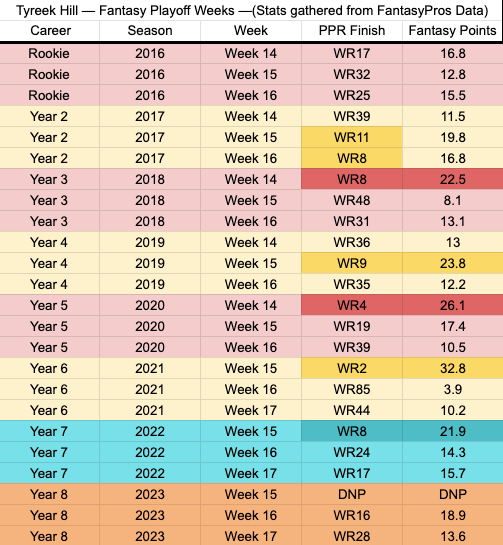
That's seven WR1 finishes in a possible 24 fantasy playoff weeks (29%) and five games tallying 20 or more PPR points (21%). Not exactly the best return on a first-round fantasy pick, particularly when you hope he cracks 20 points in your lineup.
What about Amon-Ra St. Brown?
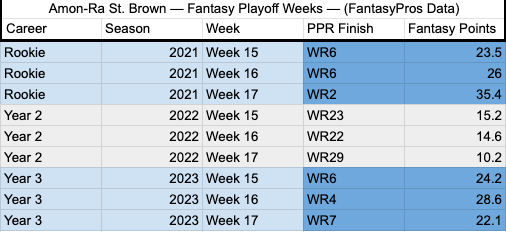
It pays to be a quarterback-friendly target who can rack up easy receptions and stack those PPR points. Malik Washington profiles as the type of player who can fill this specific role through the Dolphins' ultra-speedy lens.
Brugler: "Washington has extraordinary quickness and gets up to top speed in a hurry to immediately put cornerbacks in conflict (Malik Nabers and Rome Odunze were the only players in the 2024 draft class who had more catches of 20-plus yards in 2023)."
Now, the Dolphins and Tua need to be willing to take the easy stuff and not always go big-play hunting. This will take some time, but it seems to be in Mike McDaniel's plans.
Passion and toughness.
— Miami Dolphins (@MiamiDolphins) April 28, 2024
The call that made @malik_w2 a Dolphin 📞 pic.twitter.com/49jLCHlpnX
That's a short clip of Dolphins GM Chris Grier talking to Malik Washington from Miami's war room on Day 3 of the NFL Draft. Grier says McDaniel "zeroed in on" Washington and had been "bugging him to draft him the past couple rounds." McDaniel hops on the call to say "that's an understatement. I've been seriously annoying towards him."
McDaniel adds: "Your rookie year can be very productive if you're a pro, which I know you can immediately, because you're going to have the opportunity and it can be as much as you want it."
Ten days later, the Miami Dolphins signed Odell Beckham Jr. to a 1-year contract with $1.2 million guaranteed. To put that deal in perspective, though, last offseason OBJ signed a 1-year contract with the Ravens for $13.835 million guaranteed.
The Odell signing smacks of vanity. Mike McDaniel is a vibes-based coach, and although I only watched a bit of the first episode of the in-season Miami Dolphins Hard Knocks (seriously, did anyone watch that?), I saw enough to confirm my vibes-based take: McDaniel talks to the camera about how he is there to support his players "on their journey" and blah-blah-blah.
Odell Beckham Jr.'s journey, much like Jordan Poyer's, is nearing the end of his playing career. I do not expect this signing to greatly alter Malik (or Tahj) Washington's fantasy prospects in 2024 or beyond, and if anything it allows the rookies to work in silence and acclimate as Tyreek and OBJ suck up all the media attention they can handle.
Regardless, Malik Washington probably isn't on the redraft radar heading into summer and fall and the OBJ signing does a lot to mask his potential. Just be sure to grab him off the waiver wire before the Dolphins BYE week (at latest).
In dynasty, Malik Washington is currently the WR20 (42nd overall player) in superflex rookie rankings, according to 43 experts on FantasyPros. Malik has an average draft position of Pick 40 in non-superflex formats.
Keep Trade Cut currently ranks Malik Washington as the #246 overall player in superflex tight-end premium dynasty formats with half-PPR scoring, one spot behind Jonathan Mingo and two spots behind a late 2025 3rd-round rookie pick.
Take advantage while you can.
